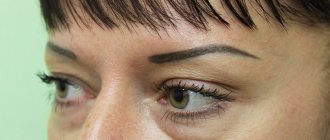What is canthoplasty, the essence and features of the operation?
Canthoplasty is a surgical intervention in aesthetic surgery, the purpose of which is to change and create a new look, rejuvenate the skin of the eyelids and periorbital area. The anti-aging effect is due to the tightening or removal of the ligament responsible for opening the upper eyelid.
Plastic surgery provides high aesthetic results: wrinkles are smoothed out, the skin becomes smooth, uniform, and the eyes are revealed. Correction can be combined with other beauty procedures.
Indications
Indications for the procedure are as follows:
- “Mongoloid” eyes (swelling of the upper eyelid fold and epicanthus);
- narrow eyes;
- age-related changes in the eyelids (overhanging fold of the upper eyelid above the eye);
- bags under the eyes;
- “round bulging” eyes;
- asymmetry;
- consequences of inflammatory processes;
- congenital pathologies (incomplete cleft eyelid);
- deformations due to injuries, burns, etc.
In what cases is eye enlargement surgery prescribed?
The surgical procedure is indicated not only to achieve an aesthetic result with a narrow palpebral fissure, oriental incision or ptosis, but also for various ophthalmological pathologies caused by weakness of the eye muscles, decreased intraocular pressure, and other diseases.
The benefits of canthoplasty, what results can be achieved
Corrective plastic surgery solves the problems of eversion of the eyelids, facial asymmetry with damage to the trigeminal and facial nerves, exophthalmos (bulging eyes), sagging eyelids, and helps to achieve good results in correcting the incision. After the procedure, the face looks younger, features become expressive, and wrinkles at the outer edge of the eyelids disappear. The incision becomes “cat-shaped”, in the form of an tonsil.
Indications for eye surgery
The main indication for plastic surgery is the patient's desire to change the incision. As a result of the correction, the eyes are given an almond shape. Other indications include:
- congenital developmental defects;
- ectropion or inversion of the skin of the eyelids;
- bulging eyes caused by endocrine pathology;
- sad appearance due to drooping of the outer corners of the eyes.
Plastic surgery is performed with the desire to stretch the outer corner upward and get rid of gravitational ptosis. In most cases, the operation is carried out at the request of the patient, but during the conversation the doctor must objectively evaluate the client’s attitude towards his own appearance.
Possible complications
Complications after canthoplasty arise due to surgeon errors made during the intervention, or due to non-compliance with medical recommendations by the patient. Because of this, the open wound becomes infected, which leads to inflammation and suppuration of the eye. The use of drops containing antibiotics helps eliminate this complication.
The second common consequence of canthoplasty is a rough and noticeable scar. This is caused by both medical errors and the peculiarities of the location of the eye defect, which is why it was necessary to make an incision in the wrong place (not along the natural crease of the eyelid).
The third common complication is tightening of the postoperative suture. This process is considered uncontrolled. It is important to regularly visit the surgeon after canthoplasty in order to notice the tightening of the suture in the early stages and take the necessary measures in a timely manner.
How to remove stitches after blepharoplasty
Most patients are concerned about what their surgical scars will look like, where they will be located, and how long it will take to fully recover.
Less commonly, persistent dry eye occurs after the procedure. This complication develops due to damage to the lacrimal canal. Due to excessive tightening of the tendons, the eyelid may turn outward. In addition, it is possible for the suture to diverge, which leads to heavy bleeding. In extreme cases, eyelid discrepancy is observed, which is explained by excessive tightening of the skin.
During the rehabilitation period, patients often experience severe eye asymmetry. This complication is considered a normal variant. The appearance of asymmetry is associated with uneven tissue restoration in the area where surgery was performed. However, if the situation does not change after 30 days, you need to contact your doctor again.
Canthoplasty: types and results
Intervention to change the shape of the eyes today is considered to be a routine, relatively uncomplicated procedure. Depending on the goals, the surgeon decides on the technique to perform. There are several varieties:
- Canthopexy. It is a correction of the outer corners of the eyes, performed under local anesthesia for about 2 hours. During the operation, the surgeon makes an incision on the outer corner, removes the tendon and tightens it to the periosteum with suture material. When tensioned, it is adjusted and the new position of the outer corner is fixed.
- Lateral. The purpose of the method is to stretch the cut, giving special expressiveness to the look. It often complements traditional blepharoplasty and improves the appearance of the skin in the periorbital area.
- Medial or median. The procedure solves the problem of defects in the inner corners and models an expressive almond-shaped gaze. Medial correction also goes well with other beauty procedures.
- Epicanthoplasty. It is carried out to remove large folds of skin and subcutaneous fat. This type is especially popular among those with an Asian cut and severe ptosis.
The doctor decides on treatment tactics at the consultation stage. At the same time, they design a future new look and discuss the wishes of the patient himself.
Blepharoplasty result
- Elimination of age-related changes in the periocular area.
- Lifting sagging skin on the upper and lower eyelids.
- Getting rid of excess fatty tissue on the eyelids.
- Tightening of the periorbital muscles.
- Formation of a new shape and/or shape of the eyes.
- Rejuvenates the appearance of the entire face.
If you want to find out how much it costs to have blepharoplasty in Moscow in our clinic, and also make an appointment with SM-Plastika specialists, just call: +7 (495) 777-48-05 .
Our advantages
Experienced surgeons
Modern equipment
Free consultation
Affordable prices
European service
How is eye enlargement surgery performed?
Despite the small volume of surgical intervention, they carefully prepare for plastic surgery. During the conversation, they find out the clinical and life history, possible contraindications, and choose the type of pain relief.
Preparing for eye enlargement surgery
Preparation includes a set of measures that clarify the patient’s current health status:
- blood and urine tests;
- ECG, fluorography;
- examination by an ophthalmologist (condition of the fundus vessels, diagnosis of ophthalmological pathologies);
- consultation of specialized specialists in case of complicated clinical history.
The package of documents for surgical intervention is basic, however, it can be expanded at the discretion of the operating surgeon. Preparation includes following a diet a week before plastic surgery, eliminating alcohol and smoking for several days, and taking certain medications on the day of the procedure.
Technique of the operation
Plastic correction is performed under general anesthesia or local anesthesia. In most cases, surgeons prefer anesthesia. The algorithm includes several sequential stages:
- marking the impact zone with a special marker;
- pain relief or general anesthesia;
- cutting the skin along the upper eyelid or inside the conjunctival sacs;
- exposure of tendon and muscle structures;
- working with muscle and tendon tension;
- removal of excess subcutaneous fat;
- suturing the wound, applying a sterile bandage.
If necessary, the intervention is combined with traditional blepharoplasty, contouring, lifting, and other methods of appearance correction in aesthetic surgery.
Excision of tissue is performed not only with a scalpel, but also with a laser beam. The popularity of laser in recent years has been justified by its high aesthetic results. If the patient’s condition is not in danger, he can go home a day later with recommendations.
How long does the operation take?
The duration is determined by the volume of intervention and the need for other types of surgical intervention. On average, the patient’s time on the operating table does not exceed 1.5–2 hours.
Reviews
Reviews about the procedure are mostly positive. The patients are satisfied with the results obtained.
The disadvantages include the inconvenience of the recovery period: the inability to sleep on your side, leave the house for the first time, wear dark glasses, etc.
Some girls claim that during the rehabilitation period they experienced a temporary deterioration in vision, as well as burning and itching.
Remember that eye enlargement surgery sometimes carries unnecessary risks, since the new size of your eyes does not always harmonize with the rest of your facial features! But to prevent this from happening, you should choose the right doctor!
December 6, 2021 by anna
What is the difference between canthoplasty and canthopexy?
Canthopexy is often considered not as a variation, but as a synonym for traditional canthoplasty. This is partly true. Canthoplasty has a wide range of indications; it is used to remove aesthetic defects and to treat many ophthalmological diseases associated with eversion or sagging of the eyelids, and bulging eyes.
Canthopexy has only an aesthetic purpose. The procedure is aimed at stretching the outer corner of the eyes, creating the effect of a cat's gaze. In addition, canthopexy is minimally invasive and involves a small amount of surgical intervention.
Contraindications
Surgery has some limitations. The operation is not performed if:
- Blood diseases, including poor clotting.
- Severe diseases of the heart, blood vessels and kidneys.
- Diabetes mellitus.
- Myopia.
- Dry eye syndrome.
- Tumor neoplasms, including retinoblastoma.
- Increased intraocular pressure.
- Inflammatory processes in the body, including conjunctivitis.
- Cataracts.
- Glaucoma.
- Severe myopia.
It is important not to hide existing diagnoses from the surgeon, since they can cause serious complications after plastic surgery.
How does a patient recover after canthoplasty and canthopexy?
The rehabilitation period does not exceed 14 days. After laser excision of the skin, recovery lasts only 7-10 days. It takes a month to completely rehabilitate the body and tissues. It is then that the final result can be assessed. After a well-performed operation, the face looks fresh, young, the corners of the eyes are tightened, and there are no bags under the eyes.
If all medical recommendations are followed, the risk of complications is virtually eliminated. The result of canthoplasty lasts about 8-10 years. The main reason for correction is age-related changes in subcutaneous structures.
What effect should you expect?
The first results will be visible after the swelling subsides (approximately a month after surgery). And after 2-3 months you can admire the “new” eyes, because after the operation:
- a double fold will appear on the upper eyelid (if it is absent);
- bags and wrinkles under the lower eyelid will disappear;
- the overhang of the upper eyelid over the eye will be eliminated;
- the gaze will “open”, become expressive, the size of the eyes will visually increase, and the face will become significantly “younger”.
Regarding the durability of the effect, doctors give an average of up to 15 years (age-related changes make the results less noticeable every year).
Before and after
Contraindications to canthoplasty and canthopexy
Any surgical intervention is stressful for the body and therefore requires special preparation. The surgeon will refuse surgery for the following diseases or conditions:
- pregnancy, lactation;
- history of diabetes mellitus;
- endocrine pathologies;
- severe dysfunction of internal organs and systems;
- oncology of any localization;
- cardiovascular diseases;
- acute infectious processes;
- chronic conjunctivitis.
The doctor may decide to perform canthoplasty with relative contraindications, when the clinical condition is transient, resolves over time, and is not caused by severe organ or systemic pathologies.
Who is indicated for iridoplasty?
Surgical correction of the iris is most often prescribed to patients who have suffered eye trauma or have congenital developmental anomalies.
Indications for iridoplasty may include the following pathologies:
- post-traumatic cataract;
- scarring of the iris;
- adhesions in the front or back of the iris;
- a thorn resulting from a burn;
- degenerative tissue changes;
- removal of the vitreous;
- aniridia (absence of the iris).
The operation cannot be performed if the patient has malignant tumors of the eye orbit, infectious and inflammatory diseases in the anterior part of the eye.











